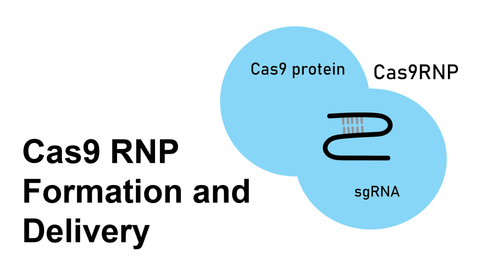Ribonucleoprotein (RNP) complex delivery for CRISPR/Cas

The success of CRISPR gene editing experiments is largely dependent on the successful delivery of the necessary elements into the nucleus. A Cas protein such as Cas9 and a guide RNA (gRNA) in their complexed form must enter the cell’s nucleus in order to make changes to the DNA. Improvements on the methods and manner of delivery of these ribonucleoprotein (RNP) complexes have been made in order to improve efficiency and minimize off-target effects. This blog post reviews the current state of RNP complex delivery systems.
CRISPR plasmid transfection
Using a CRISPR plasmid to deliver Cas and gRNA into the cell is arguably the least effective of the methods currently used. Delivery of the plasmid into the cell is inconsistent, and equal expression can’t be guaranteed across cells. Because the DNA persists in the cell after the desired editing takes place, it leaves behind fragments and off-target edits in the genome like a footprint.
Introducing a plasmid into a cell also takes longer to achieve the desired active product of an RNP. The plasmid enters the nucleus, Cas9 mRNA and the gRNA are transcribed and exported, translated, and the RNP forms and returns to the nucleus to edit (Figure 1A). This approach is both time consuming and inefficient.
Preparing a RNP using separately purified Cas9 and gRNA
A more direct method of delivery is to generate and deliver RNP complexes to the cell instead of allowing the transcription and translation to happen in the cell. Cas and gRNA are separately purified and then assembled to form the RNP (Figure 2). Cas proteins tend to purify well in E. coli despite their large sizes. Editing efficiency is correlated with Cas protein purity, so it’s crucial that high quality Cas is used in experiments.
CasRNPs are an improvement on plasmid transfections because the Cas protein is cleared from the system within 24 hours, decreasing off-target effects. The method also saves time, as the active complex is what’s being delivered straight to the nucleus of the cell (Figure 1B).
Direct expression and purification of CasRNP complexes
A novel method for producing RNPs removes the need for separate generation of Cas and gRNA. In a 2019 Nature paper, researchers from Hubei University in China directly purified Cas9 RNPs from E. coli. Within one plasmid, Cas9 was tagged with CL7 followed by the gRNA transcription element. The Cas9 and sgRNA self-assembled in E. coli and then were purified in one step using the high affinity interaction between the CL7 tag and Im7 resin (Figure 3). Using this method, RNP purity increased from 58% to 89% compared to using a His-tag. The complex was highly stable and did not require the addition of any RNAse inhibitors.
As for RNP nuclease activity, 200 ng of CasRNPs fully cleaved 300 ng of plasmids in 30 min. at 37⁰C. When a purified Cas9RNP was mixed with ssDNA, in vivo HDR efficiency increased to 19% from 11% compared to when Cas9, sgRNA, and ssDNA expressed separately were combined. The RNPs were delivered to the cells by lipofectamine CRISPRMAX.
Conclusion
CRISPR technology still has a lot of room for improvement in terms of boosting efficiency and diminishing off-target effects. Incremental improvements to delivery methods are moving us closer to an increasingly viable solution for genetic editing in humans.



